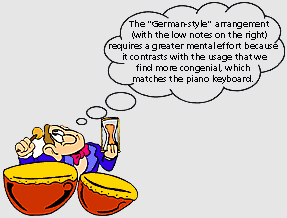|
ARRANGING THE TYMPANI |

|
Generally, the tympani are arranged in a semi-circle in front of the timpanist, in increasing order of range, starting from the left.
The "German-style" arrangement (with the low notes on the right) requires a greater mental effort because it contrasts with the usage that we find more congenial, which matches the piano keyboard. In broad outline, the different tympani arrangements are a restatement of the controversy over numbering the four mallets for keyboards where some schools use the number 1 to indicate the mallet on the extreme right and others the one on the extreme left. The Italian school takes into consideration the immediacy of reading and the greater ease of performance for students who are studying the keyboard instruments along with the tympani (and, thus, are used to always having the low notes on the left). In addition, the timpanist, unlike his other colleagues (such as, for example, the double bass player who can add a fifth string to obtain sounds that are even more grave) adopts new tympani, in addition to the four basic ones, only for the acute register. Since, in these cases, if you don't adopt the progressive order from left to right, you would have to change all the numbering, assigning number one to the more acute tympani. However, this doesn't mean that the "Italian-style" arrangement of the tympani can't be changed if it turns out to be more advantageous for performance. In fact, there are several pieces where it's better to change the arrangement of the tympani, or the traditional tuning sequence from grave to acute. We have written several studies with variations on the initial tuning arrangement precisely for this eventuality. In practice, these are studies where the beginning notes do not follow the sequence grave, medium acute (pp. 105-107 “Timpani” method). With this system the tympani are not moved but only change their tuning arrangement, if the range of the tympani allows it, with the more acute note on the left and the more grave on the right. |